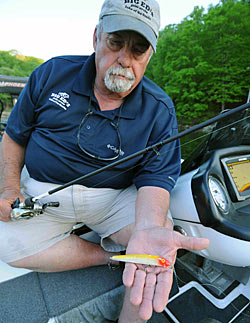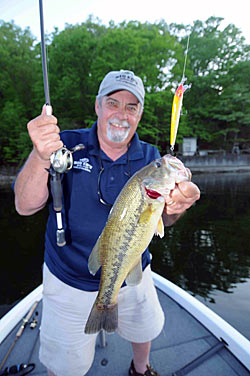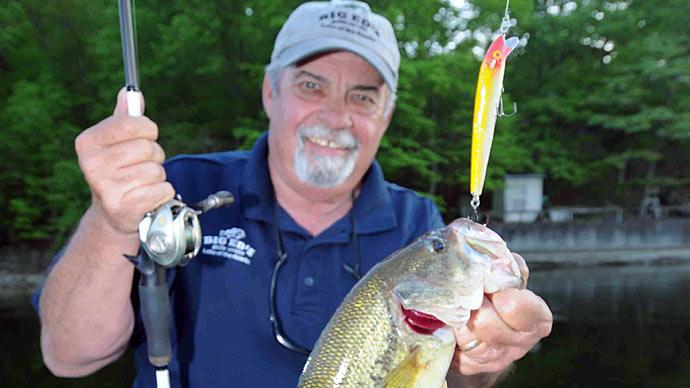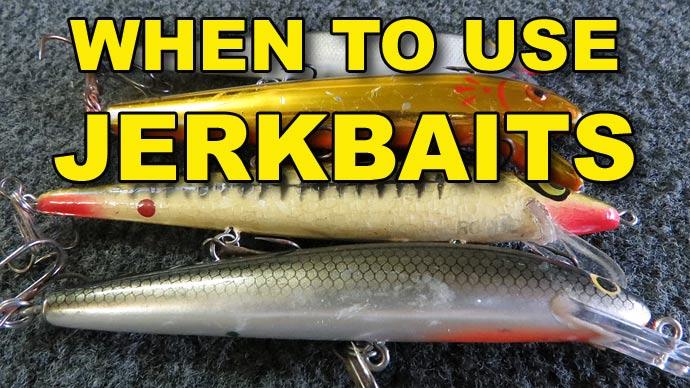
Ed Franko sometimes thinks “old school” when selecting his lures for bass fishing.
The Lake of the Ozarks guide likes to fish occasionally with retro lures, and one of his old-time favorites for catching bass in the spring is a Smithwick Rattlin’ Rogue floating stickbait. Franko started fishing floating stickbaits in the mid-1970s on Lake Ouachita when he discovered the Whopper Stopper Hellcat. “I always had such a good time with that, and I have always enjoyed fishing topwater baits,” Franko says. “There is nothing more exciting in my book than having a fish come up and blast it.”
When the Hellcat was discontinued, and Franko had trouble finding more of the baits, he switched to the floating Rogue for his topwater tactic. He prefers using the floating model rather than the suspending Rogue because the floater works better as a surface lure.
The proprietor of Big Ed’s Guide Service relies on his floating Rogue during the spawn and post-spawn. “As soon as I start seeing fish up on beds, then I will start throwing it,” Franko says. He usually works the lure in the backs of spawning pockets where he sees bass on nests. The floating Rogue will catch bass on nests or cruising the shallows during the spawn. It is also an effective lure for catching bass protecting fry during the post-spawn, so Franko suggests the lure remains productive for a month or more during the spring.
His floating Rogue tactic produces strikes during the low light conditions of early morning and late evening. “It works extremely well on a cloudy day and in the rain,” Franko says. “If you have a little misty rain, it is on fire.” Franko also likes a slight chop on the water, but if the surface is too choppy, he switches to a splashier topwater such as a Zara Spook.
The floating Rogue also works well for Franko in calm weather when the water surface is slick. “The reason you can get by with that is because the lure is quiet,” he says. “It is not a loud bait. Everything nowadays flutters, sputters, or whines in some way, and the noisier it is, the better. Well, this is something the fish haven’t seen, and it is quiet.” So the Rogue is an ideal finesse-style surface lure for fishing in clear water.

The only modification Franko makes on his Rogues is changing the lure's color. He paints the lure with an airbrush, coloring it with a red head, yellow back, white belly, and a splash of red on the belly. The color combination helps him see the lure better on the surface and when it dives in the water. Franko believes bass dislike the colors because the fish frequently smash his topwater offering. “I don’t know why they dislike it so much, but there are days when they will hit it as soon as it hits the water,” he says.
Whenever he spots bass in the spawning pockets, Franko throws his Rogue to the shallows and waits for the rings from the lure’s splashdown to disappear. “Then I just barely pop it or twitch it a little bit, so it swims a little bit and then comes back to the surface,” he said. Franko repeats the sequence, working the lure out to water in the 4 to 5-foot range, then reels in the lure to cast to another spot. While fan-casting the pocket, Franko might vary his retrieve until he finds a sequence the fish prefer.
Franko frequently sets up his clients with floating Rogues because the lures are easy for them to work. “The only thing I have to worry about with them is sometimes they throw the lures up in the trees,” he says.
The floating Rogue can be thrown on either spinning or baitcasting tackle, but Franko prefers employing a baitcast reel because he can cast the Rogue more accurately. The gear for his floating Rogue includes a 6-foot, 7-inch medium-fast action Lew’s Speed Stick jerkbait rod matched with a Lew’s baitcast reel. Franko fills his reel with 10-pound monofilament, which he prefers over fluorocarbon because the monofilament floats, whereas fluorocarbon sinks and creates too much of a bow in the line when the Rogue sits on the surface.
If a bass blows up on the floating Rogue and misses, Franko lets the lure sit for a while to see if the fish will return and nose it. If Franko sees the bass near his lure, he will twitch the Rogue, and usually, the fish will blast it. Sometimes the fish will follow the lure when he keeps twitching it and will eventually take a swipe at the Rogue, especially if he retrieves the lure faster. Whenever bass short strike his Rogue, Franko will make another cast to the same spot to see if the fish will hit the stickbait again.
The Missouri guide warns that patience is required when setting the hook after a bass blows up on the Rogue. “The biggest thing with that lure is you don’t want to set the hook when you hear the splash because if you do, you will take it away from that fish, and it will never get a chance to get ahold of the lure,” Franko says. “So you want to wait until you feel a little pull, and once you feel that little bit of weight, you sweep the rod. Then keep the rod at about the 11 o’clock position and continue to reel.”
When bass are on beds or protecting fry, try a lure from the good old days for fun topwater action.
BassResource may receive a portion of revenues if you make a purchase using a link above.




